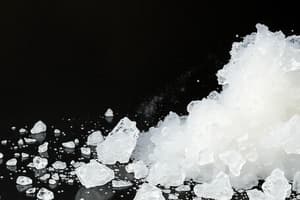Podcast
Questions and Answers
What is the atomic number of sodium?
What is the atomic number of sodium?
- 11 (correct)
- 13
- 10
- 12
What is the primary form in which sodium is found in nature?
What is the primary form in which sodium is found in nature?
- As a solid metal
- As a pure element
- In the form of salts (correct)
- In gaseous form
Which of the following best describes sodium's reactivity?
Which of the following best describes sodium's reactivity?
- Reacts only with oxygen
- Reacts mildly with water
- Very stable and unreactive
- Highly reactive, especially with water (correct)
What is the melting point of sodium?
What is the melting point of sodium?
Which of the following compounds is sodium NOT known to form?
Which of the following compounds is sodium NOT known to form?
Which isotopes of sodium is considered stable?
Which isotopes of sodium is considered stable?
What essential role does sodium play in living organisms?
What essential role does sodium play in living organisms?
What precautions should be taken when handling sodium?
What precautions should be taken when handling sodium?
Flashcards are hidden until you start studying
Study Notes
NA (Sodium, Chemical Element)
- Symbol: Na
- Atomic Number: 11
- Classification: Alkali metal
- Position in the Periodic Table: Group 1, Period 3
Physical Properties
- Appearance: Silvery-white metallic solid
- Density: 0.97 g/cm³
- Melting Point: 97.79 °C
- Boiling Point: 883 °C
Chemical Properties
- Reactivity: Highly reactive, especially with water; reacts to form sodium hydroxide and hydrogen gas.
- Electropositivity: Strong electropositive nature; readily loses one electron to form cations (Na⁺).
- Compounds: Forms various compounds such as sodium chloride (NaCl), sodium bicarbonate (NaHCO₃), and sodium sulfate (Na₂SO₄).
Occurrence
- Natural Abundance: Commonly found in nature, primarily in the form of salts (e.g., halite).
- Biological Role: Essential for living organisms; important in nerve function and maintaining fluid balance.
Uses
- Industrial: Used in the production of glass, soaps, and paper.
- Food Industry: Commonly used as table salt (sodium chloride) for seasoning and preservation.
- Chemical Reactions: Acts as a reducing agent in chemical synthesis.
Safety
- Hazards: Highly flammable; reacts violently with water and air.
- Handling Precautions: Should be stored under oil or in an inert atmosphere to prevent reactions.
Isotopes
- Stable Isotopes: Sodium has only one stable isotope, Na-23.
- Radioactive Isotopes: Several radioactive isotopes exist but are not commonly encountered.
Key Facts
- Sodium is crucial for various physiological functions including muscle contraction and nerve impulse transmission.
- The sodium-potassium pump is vital for maintaining cellular homeostasis.
Sodium (Na) Overview
- Symbol: Na, with an atomic number of 11.
- Classified as an alkali metal, positioned in Group 1, Period 3 of the periodic table.
Physical Properties
- Appears as a silvery-white metallic solid.
- Density measured at 0.97 g/cm³, indicating it is lighter than water.
- Melting point is 97.79 °C, while boiling point is 883 °C.
Chemical Properties
- Sodium is highly reactive, particularly with water, producing sodium hydroxide and hydrogen gas.
- Exhibits strong electropositive character by readily losing one electron to form sodium cations (Na⁺).
- Forms various compounds, including sodium chloride (NaCl), sodium bicarbonate (NaHCO₃), and sodium sulfate (Na₂SO₄).
Occurrence
- Naturally abundant, primarily found as salts such as halite.
- Plays a crucial role in biological systems, essential for nerve function and fluid balance.
Uses
- In industry, sodium is key in manufacturing glass, soaps, and paper products.
- Widely utilized in the food industry as table salt (sodium chloride) for flavoring and preservation.
- Acts as a reducing agent in various chemical reactions during synthesis.
Safety Precautions
- Sodium is highly flammable and reacts vigorously with both water and air, posing hazards.
- Must be stored under oil or in an inert atmosphere to mitigate risks of dangerous reactions.
Isotopes
- Sodium has one stable isotope, Na-23.
- While several radioactive isotopes exist, they are rarely encountered in typical scenarios.
Key Biological Functions
- Essential for several physiological processes, including muscle contraction and nerve impulse transmission.
- The sodium-potassium pump is critical for cellular homeostasis, regulating ion concentrations in cells.
Studying That Suits You
Use AI to generate personalized quizzes and flashcards to suit your learning preferences.




